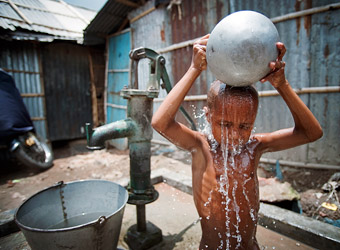Water
According to the Millennium Development Goals Report 2012, 783 million people, or 11 per cent of the global population, remain without access to an improved source of drinking water. Such sources include household connections, public standpipes, boreholes, protected dug wells, protected springs and rainwater collections. The world has met the MDG drinking water target five years ahead of schedule but work is not yet completely done. We must not forget that since it is not yet possible to measure water quality globally, dimensions of safety, reliability and sustainability may actually be slowing progress. Furthermore, there are regions particularly delayed such as Sub-Saharan Africa where over 40 per cent of all people without improved drinking water live.

The United Nations has long been addressing the global crisis caused by insufficient water supply to satisfy basic human needs and growing demands on the world’s water resources to meet human, commercial and agricultural needs. The United Nations Water Conference (1977), the International Drinking Water Supply and Sanitation Decade (1981-1990), the International Conference on Water and the Environment (1992) and the Earth Summit (1992) — all focused on this vital resource. The Decade, in particular, helped some 1.3 billion people in developing countries gain access to safe drinking water.
One of the most important recent milestones has been the recognition in July 2010 by the United Nations General Assembly of the human right to water and sanitation. The Assembly recognized the right of every human being to have access to sufficient water for personal and domestic uses (between 50 and 100 litres of water per person per day), which must be safe, acceptable and affordable (water costs should not exceed 3 per cent of household income), and physically accessible (the water source has to be within 1,000 metres of the home and collection time should not exceed 30 minutes).
UN system activities specially focus on the sustainable development of fragile and finite freshwater resources, which are under increasing stress from population growth, pollution and the demands of agricultural and industrial uses.
The crucial importance of water to so many aspects of human health, development and well-being led to the inclusion of a specific water-related target in the Millennium Development Goals (MDGs). At the same time, every target of the MDGs depends on the achievement of the water and sanitation target: eradicating extreme poverty and hunger; achieving universal primary education; promoting gender equality and empowering women; reducing child mortality; improving maternal health; combating HIV, AIDS, malaria and other diseases; and ensuring environmental sustainability.
To help raise public awareness on the importance of water for life, the General Assembly declared 2003 International Year of Freshwater. Also in 2003, the Chief Executives Board (CEB), the coordinating body for the entire UN system, established UN Water — a UN inter-agency coordination mechanism for all freshwater and sanitation related issues. To further strengthen global action to meet the water-related MDG targets, the General Assembly proclaimed the 2005-2015 period International Decade for Action, “Water for Life”. The Decade began on 22 March 2005, which is observed annually as World Water Day.
Access to water in the Millennium Development Goals Report 2012
- The world has met the MDG drinking water target five years ahead of schedule.
- In 2010, 89 per cent of the world’s population was using improved drinking water sources, up from 76 per cent in 1990. If current trends continue, 92 per cent of the global population will be covered by 2015.
- The number of people using improved drinking water sources reached 6.1 billion in 2010, up by over 2 billion since 1990.
- China and India alone recorded almost half of global progress, with increases of 457 million and 522 million, respectively.
- The work is not yet done. 11 per cent of the global population—783 million people—remains without access to an improved source of drinking water and, at the current pace, 605 million people will still lack coverage in 2015. .
- In four of nine developing regions, 90 per cent or more of the population now uses an improved drinking water source. In contrast, coverage remains very low in Oceania and sub-Saharan Africa, neither of which is on track to meet the MDG drinking water target by 2015. Over 40 per cent of all people without improved drinking water live in sub-Saharan Africa.
- Since it is not yet possible to measure water quality globally, dimensions of safety, reliability and sustainability are not reflected in the proxy indicator used to track progress towards the MDG target. As a result, it is likely that the number of people using improved water sources is an overestimate of the actual number of people using safe water supplies.
- Coverage with improved drinking water sources for rural populations is still lagging. In 2010, 96 per cent of the urban population used an improved drinking water source, compared with 81 per cent of the rural population. In absolute terms, because of population growth, the number of people without an improved source in urban areas actually increased. In rural areas, on the other hand, the number of people without an improved source of water decreased, from 1.1 billion in 1990 to 653 million in 2010. However, the gap between urban and rural areas still remains wide, with the number of people in rural areas without an improved water source five times greater than in urban areas.